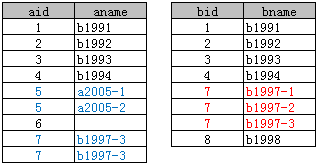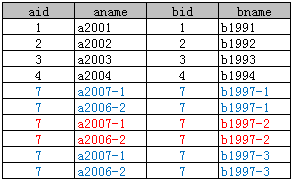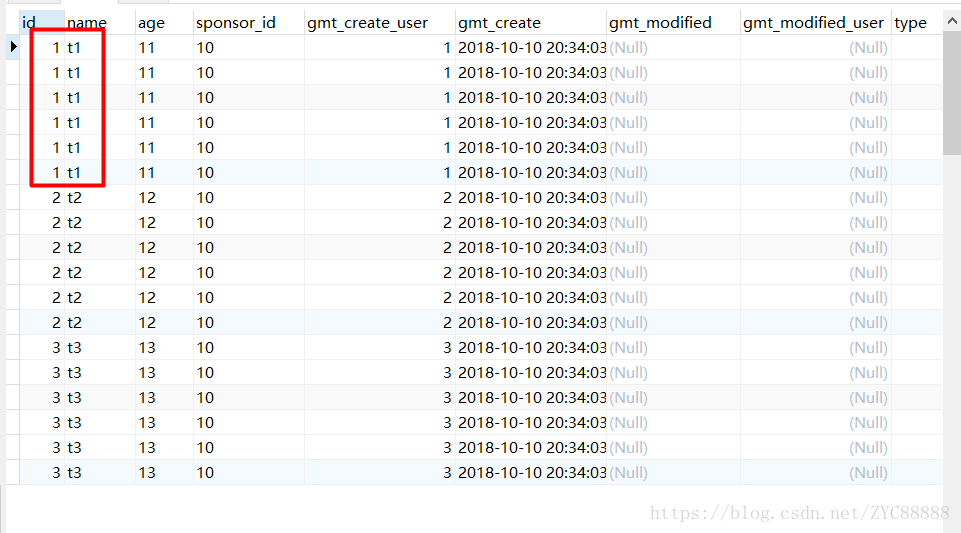SQL left join 左表合并去重技巧总结
建表:
CREATE TABLE `table1` (
`id` int(11) NOT NULL AUTO_INCREMENT,
`name` varchar(60) DEFAULT NULL,
`age` varchar(200) DEFAULT NULL,
`sponsor_id` varchar(20) DEFAULT NULL COMMENT '业务发起人',
`gmt_create_user` int(11) NOT NULL COMMENT '创建人id',
`gmt_create` datetime NOT NULL DEFAULT CURRENT_TIMESTAMP COMMENT '创建时间',
`gmt_modified` datetime DEFAULT NULL COMMENT '修改时间',
`gmt_modified_user` int(11) DEFAULT NULL COMMENT '修改人id',
PRIMARY KEY (`id`)
) ENGINE=InnoDB AUTO_INCREMENT=12 DEFAULT CHARSET=utf8mb4 COMMENT='测试表1';
CREATE TABLE `table2` (
`kid` int(11) NOT NULL AUTO_INCREMENT,
`name` varchar(60) DEFAULT NULL,
`sponsor_id` varchar(20) DEFAULT NULL COMMENT '业务发起人',
`type` int(11) NOT NULL COMMENT '创建人id',
`gmt_create` datetime NOT NULL DEFAULT CURRENT_TIMESTAMP COMMENT '创建时间',
`gmt_modified` datetime DEFAULT NULL COMMENT '修改时间',
`gmt_modified_user` int(11) DEFAULT NULL COMMENT '修改人id',
PRIMARY KEY (`kid`)
) ENGINE=InnoDB AUTO_INCREMENT=12 DEFAULT CHARSET=utf8mb4 COMMENT='测试表2';插入数据:
INSERT INTO `table1`(`id`, `name`, `age`, `sponsor_id`, `gmt_create_user`, `gmt_create`, `gmt_modified`, `gmt_modified_user`) VALUES (1, 't1', '11', '10', 1, '2018-10-10 20:34:03', NULL, NULL);
INSERT INTO `table1`(`id`, `name`, `age`, `sponsor_id`, `gmt_create_user`, `gmt_create`, `gmt_modified`, `gmt_modified_user`) VALUES (2, 't2', '12', '10', 2, '2018-10-10 20:34:03', NULL, NULL);
INSERT INTO `table1`(`id`, `name`, `age`, `sponsor_id`, `gmt_create_user`, `gmt_create`, `gmt_modified`, `gmt_modified_user`) VALUES (3, 't3', '13', '10', 3, '2018-10-10 20:34:03', NULL, NULL);
INSERT INTO `table1`(`id`, `name`, `age`, `sponsor_id`, `gmt_create_user`, `gmt_create`, `gmt_modified`, `gmt_modified_user`) VALUES (4, 't4', '14', '20', 4, '2018-10-10 20:34:03', NULL, NULL);INSERT INTO `table2`(`kid`, `name`, `sponsor_id`, `type`, `gmt_create`, `gmt_modified`, `gmt_modified_user`) VALUES (1, 't1', '10', 1, '2018-10-10 20:38:10', NULL, NULL);
INSERT INTO `table2`(`kid`, `name`, `sponsor_id`, `type`, `gmt_create`, `gmt_modified`, `gmt_modified_user`) VALUES (2, 't2', '10', 1, '2018-10-10 20:38:10', NULL, NULL);
INSERT INTO `table2`(`kid`, `name`, `sponsor_id`, `type`, `gmt_create`, `gmt_modified`, `gmt_modified_user`) VALUES (3, 't3', '10', 1, '2018-10-10 20:38:10', NULL, NULL);
INSERT INTO `table2`(`kid`, `name`, `sponsor_id`, `type`, `gmt_create`, `gmt_modified`, `gmt_modified_user`) VALUES (4, 't4', '10', 1, '2018-10-10 20:38:10', NULL, NULL);
INSERT INTO `table2`(`kid`, `name`, `sponsor_id`, `type`, `gmt_create`, `gmt_modified`, `gmt_modified_user`) VALUES (5, 't5', '10', 1, '2018-10-10 20:38:10', NULL, NULL);
INSERT INTO `table2`(`kid`, `name`, `sponsor_id`, `type`, `gmt_create`, `gmt_modified`, `gmt_modified_user`) VALUES (6, 't6', '10', 1, '2018-10-10 20:38:10', NULL, NULL);
INSERT INTO `table2`(`kid`, `name`, `sponsor_id`, `type`, `gmt_create`, `gmt_modified`, `gmt_modified_user`) VALUES (7, 't7', '10', 2, '2018-10-10 20:38:10', NULL, NULL);
INSERT INTO `table2`(`kid`, `name`, `sponsor_id`, `type`, `gmt_create`, `gmt_modified`, `gmt_modified_user`) VALUES (8, 't1', '11', 1, '2018-10-10 20:38:10', NULL, NULL);
SELECT
a.*,
b.type
FROM
table1 a
LEFT JOIN table2 b ON a.sponsor_id = b.sponsor_id
WHERE
b.type = 1
AND a.sponsor_id = 10;简单说明问题出现的原因:
MySQL left join 语句格式为:A LEFT JOIN B ON 条件表达式
left join 是以A表为基础,A表即左表,B表即右表。
左表(A)的记录会全部显示,而右表(B)只会显示符合条件表达式的记录,如果在右表(B)中没有符合条件的记录,则记录不足的地方为NULL。
使用left join, A表与B表所显示的记录数为 1:1 或 1:0,A表的所有记录都会显示,B表只显示符合条件的记录。
但如果B表符合条件的记录数大于1条,就会出现1:n的情况,这样left join后的结果,记录数会多于A表的记录数。
所以解决办法 都是从一个出发点出发,使A表与B表所显示的记录数为 1:1对应关系。
解决方法:
使用非唯一标识的字段做关联
1 DISTINCT
select DISTINCT(id) from a left join b on a.id=b.aid DISTINCT查询结果是 第一个表唯一的数据 重复的结果没显示出来
SELECT
DISTINCT(a.id), a.*,
b.type
FROM
table1 a
LEFT JOIN table2 b ON a.sponsor_id = b.sponsor_id
WHERE
b.type = 1
AND a.sponsor_id = 10;SELECT
DISTINCT a.*,
b.type
FROM
table1 a
LEFT JOIN table2 b ON a.sponsor_id = b.sponsor_id
WHERE
b.type = 1
AND a.sponsor_id = 10;2 GROUP BY
select * from a left join(select id from b group by id) as b on a.id=b.aid 拿出b表的一条数据关联 使A表与B表所显示的记录数为 1:1对应关系。
SELECT
a.*,
b.type
FROM
table1 a
LEFT JOIN ( SELECT * FROM table2 GROUP BY sponsor_id ) AS b ON a.sponsor_id = b.sponsor_id
WHERE
b.type = 1
AND a.sponsor_id = 10;3 max取唯一
select * from a left join (select max(id) from table group by id) as b on a.id=b.aid 拿出b表的最后一条数据关联
SELECT
a.*,
b.type
FROM
table1 a
LEFT JOIN ( SELECT MAX( kid ), type, sponsor_id FROM table2 GROUP BY sponsor_id ) AS b ON a.sponsor_id = b.sponsor_id
WHERE
b.type = 1
AND a.sponsor_id = 10;4 IN巧用
SELECT
a.*
FROM
table1 a
WHERE
a.sponsor_id IN ( SELECT sponsor_id FROM table2 WHERE type = 1 AND sponsor_id = 10 );SELECT
a.*,
1
FROM
table1 a
WHERE
a.sponsor_id IN ( SELECT sponsor_id FROM table2 WHERE type = 1 AND sponsor_id = 10 );
(搜索公众号Java知音,回复“2021”,送你一份Java面试题宝典)
比如有个主表M,卡号是主键。


SELECT A.卡号,B.手机号码
FROM A
LEFT JOIN B
ON A.客户号=B.客户号
WHERE B.联系方式='2'相信很多人这样写,估计实际工作中也会看到这样的语句,并不是说这么写一定会错误,实际SQL表达的思想一定是要符合业务逻辑的。
前面已经说清楚,所有卡号对应的手机号码。所有卡号,所以首先肯定以A表作为主表,并且左关联B表,这样A表所有的卡号一定会显示出来,但是如果B表的筛选条件放到最外层,这样就相当于将A表关联B表又做了一遍筛选,结果就是

实际工作中表结构肯定没这么简单,关联的表也会很多,当有很多条件时,最好这么写
SELECT A.卡号,B.手机号码
FROM A
LEFT JOIN (
SELECT * FROM B
B.联系方式='2'
)B
ON A.客户号=B.客户号这么写的话,A表中的数据肯定会完全保留,又能与B表的匹配,不会丢失数据。
PS:
- 表结构
- Left Join
- Right Join
- Inner Join
- 表的关联修改和删除
- 笛卡尔积
1、表结构

2、Left Join
示例:2.1
Select * From A left join B on A.aid = B.bid;
- A表所有记录都会显示,A表中没有被匹配的行(如aid=5、6的行)相应内容则为NULL。
- 返回的记录数一定大于A表的记录数,如A表中aid=7行被B表匹配了3次(因为B表有三行bid=7)。
注意:在Access中A.aid、B.bid不能缩写成aid、bid,否则会提示“不支持链接表达式”,这一点不同于Where查询。
3、Right Join
示例:3.1
Select * From A right join B on A.aid = B.bid;
4、Inner Join
示例:4.1
Select * From A inner join B on A.aid = B.bid;
inner join 等同于Where查询如:
Select * From A, B Where A.aid = B.bid5、表的关联修改和删除
5.1修改
示例:5.1.1
update A left join B on A.aid = B.bid
set A.aname = B.bname
- aid=5、6的记录,被更新为NULL
- aid=7的记录,被更新了3次,依次是“b1997-1”、“b1997-2”、“b1997-3”,因此其结果为最后一次更新“b1997-3”
对于上述SQL同样可以将“A.aname = B.bname”改成“B.bname = A.aname”,执行后B表将会被修改,但是执行后B表会增加三行“0, a2005-1;0, a2005-2;0, a2006”,这也不难理解,因为Left Join执行后,B表会出现三行空值。
示例:5.1.2
Where条件查询在上面的SQL中同样可以使用,其作用的表也是Select查询出的关联表。如下SQL
update A left join B on A.aid = B.bid
set A.aname = B.bname
where A.aid <> 5执行后A表的结果:

这里只讲述left join,因为right join 和 inner join的处理过程等同于left join。另外Access中update语句中不能含有From关键字,这一点不同于其他数据库。
5.2删除
在Access中是不可以通过Left Join、Right Join、Inner Join来删除某张表的记录
示例:5.2.2
Delete From A inner join B on A.aid = B.bid
where B.bname = "b1991"上述SQL的本意是删除A表中aid=1的记录,但执行后表A和表B均未发生任何变化。若想实现此目的,下述SQL可以实现
Delete From A
Where A.aid In (Select bid From B Where B.bname="b1991")6、笛卡尔积
如果A表有20条记录,B表有30条记录,则二者关联后的笛卡尔积工20*30=600条记实录。也就是说A表中的每条记录都会于B表的所有记录关联一次,三种关联方式实际上就是对“笛卡尔积”的处理方式不同。

